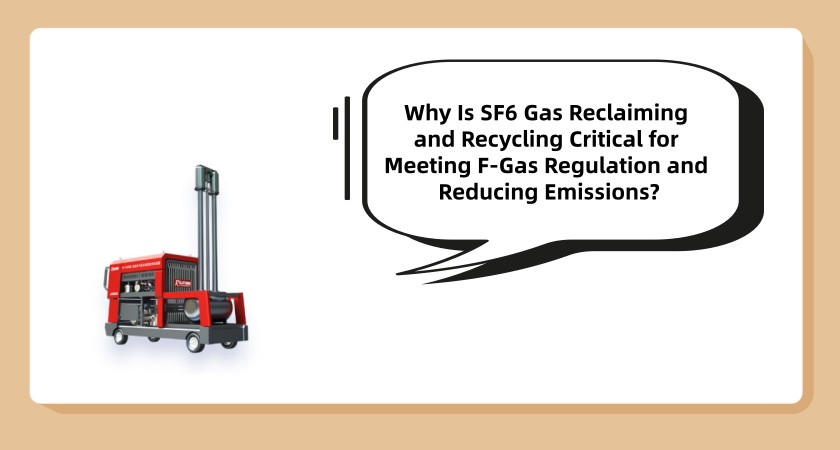Sulfur Hexafluoride (SF6) is a critical gas in the power industry, valued for its exceptional electrical insulation and arc-quenching properties—making it indispensable for high-voltage equipment like circuit breakers, transformers, and gas-insulated switchgear (GIS). However, SF6 is also one of the most potent greenhouse gases (GHGs) on the planet: its global warming potential (GWP) is 23,900 times higher than carbon dioxide (CO₂), and it remains in the atmosphere for approximately 3,200 years. This duality has made SF6 gas reclaiming and recycling a non-negotiable practice for industries aiming to reduce their environmental footprint, meet regulatory requirements, and cut operational costs.
Why SF6 Gas Reclaiming and Recycling Matters
The urgency around SF6 management stems from two core drivers: environmental responsibility and global regulation.
Environmental Impact Mitigation: Uncontrolled SF6 emissions—from equipment leaks, improper disposal, or venting during maintenance—significantly contribute to climate change. Reclaiming and recycling SF6 ensures the gas is reused instead of being released, directly reducing GHG emissions and preserving a scarce, high-performance resource.
Regulatory Compliance: Governments and regional bodies have implemented strict rules to limit SF6 use and emissions. For example, the EU’s F-Gas Regulation mandates a 79% reduction in SF6 emissions by 2030 (compared to 2014 levels), while the U.S. EPA’s Significant New Alternatives Policy (SNAP) restricts SF6 venting and promotes recycling. Non-compliance can result in heavy fines and reputational damage for businesses.
The SF6 Gas Reclaiming and Recycling Process: Key Steps
Effective SF6 reclaiming and recycling follows a standardized, industry-approved workflow (aligned with standards like IEC 60480) to ensure the gas meets purity requirements for reuse:
Gas Recovery: Using specialized SF6 recovery units, technicians extract SF6 from decommissioned or maintenance-ready equipment. These units create a vacuum to pull the gas into sealed storage cylinders, minimizing leaks during transfer.
Purification: The recovered SF6 often contains impurities—such as moisture, oil residues, and decomposition byproducts (e.g., SO₂, HF)—that degrade its performance. Purification systems use filters, dryers, and distillation to remove contaminants, restoring the gas to a purity level of 99.9% or higher.
Testing & Certification: Purified SF6 undergoes laboratory testing to verify purity, moisture content, and absence of harmful substances. Only gas that meets IEC or OEM (original equipment manufacturer) standards is cleared for reuse.
Storage & Reuse: Certified SF6 is stored in leak-tight cylinders until it is reused in new equipment or to refill existing GIS. This eliminates the need to purchase new SF6, cutting both costs and reliance on gas production (which itself has environmental impacts).
Benefits of SF6 Gas Reclaiming and Recycling
For power utilities, industrial facilities, and equipment manufacturers, investing in SF6 reclaiming and recycling delivers triple value:
Cost Savings: SF6 is expensive—costing hundreds of dollars per kilogram. Recycling reduces the need to buy new gas, lowering procurement expenses. It also avoids disposal fees associated with hazardous waste.
Risk Reduction: Compliance with F-Gas, EPA, and local regulations minimizes the risk of fines, legal action, or supply chain disruptions (many large clients now require suppliers to demonstrate sustainable SF6 management).
Brand Reputation: As stakeholders (investors, customers, communities) prioritize sustainability, adopting SF6 recycling positions businesses as leaders in environmental stewardship—enhancing trust and competitive advantage.
SF6 gas reclaiming and recycling is no longer an optional practice but a strategic necessity. By reducing greenhouse gas emissions, ensuring regulatory compliance, and cutting costs, it balances the power industry’s need for reliable equipment with global climate goals. As technology advances—with more efficient recovery units and smarter leak-detection tools—SF6 management will become even more accessible, driving a more sustainable future for high-voltage infrastructure. For any organization working with SF6, integrating reclaiming and recycling into daily operations is the first step toward long-term success.


Leave A Message
Your email address will not be published. Required fields are marked *